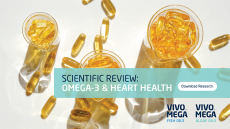DHA levels higher in breastfed infants whose mothers ate specific fish

“To the best of our knowledge, this is the first study to explore the association between maternal diet and serum LCPUFA levels in infants who have not yet started solid foods,” the Japanese researchers wrote. “The results indicated that the infants of lactating mothers who frequently consumed ‘Blue-back fish’ and/or ‘White fish’ from the list of 38 food items had higher levels of serum DHA than infants whose mothers did not consume these fish regularly… These results suggest that higher serum DHA levels might be more effectively achieved by frequent maternal consumption of ‘Blue-back fish’ and/or ‘White fish’, or by prioritizing breastfeeding rather than relying on cow’s milk formula supplemented with DHA.”
Breast milk v. cow’s milk
The trial included infants at risk of atopy due to at least one of their parents or siblings having current and/or past atopic diseases, such as asthma.
Researchers randomly assigned newborn infants to breastfeeding with or without amino acid–based elemental formula for at least the first three days of life group. In another group, breastfeeding women were supplemented with cow’s milk formula (≥5 mL/day) from the first day of life to five months of age group and children were followed up until their second birthday. The study included 312 pregnant women.
To evaluate sensitization to cow’s milk protein, this trial incorporated both cow’s milk formula (Meiji Hohoemi) and EF (Meiji Elemental formula) alongside breast milk. EF does not contain cow’s milk protein, but it does contain fundamental nutrients in approximately equivalent proportions to CMF, the researchers remarked. The cow’s milk formula was supplemented with α-linolenic acid, DHA, linolenic acid and arachidonic acid. The EF was supplemented with α-linolenic acid and linolenic acid.
The researchers collected data on maternal age, maternal body mass index, gestational weeks, birth weight and neonatal sex. Participating parents were interviewed regarding their child’s daily amount of CMF intake during follow-up visits to the outpatient clinic when their child was 5 to 6 months old. Mothers were given a self-administered questionnaire regarding their diet, which included 38 food items. The completed answers were to be brought to the visit also when the child was 5 to 6 months old. Researchers also collected blood from the infants during the time frame and prior to infant being the introduced to solid foods. In the trial, the scientists measured 25-hydroxyvitamin D, total IgE and antigen-specific IgE levels.
“Examination of the association between the infants’ feeding patterns and their serum n-3 LCPUFA levels revealed that infants who were predominantly breastfed had significantly higher levels of serum DHA, EPA, α-linolenic acid and n-3 LCPUFA compared to those who received larger amounts of cow’s milk formula to supplement breastfeeding,” the researchers wrote. “Conversely, infants who were fed less cow's milk formula had significantly lower levels of serum linolenic acid compared to those who were predominantly breastfed. No significant associations were found between feeding patterns and serum α-linolenic or n-6 LCPUFA levels.”
An ‘ideal’ location
One of the strengths of this study is that it used blood samples collected from 268 infants to measure 24 different types of fatty acids, despite the challenge of performing venous blood sampling in infants aged 5 to 6 months, the researchers wrote.
“This unique approach sets this study apart from most other studies on LCPUFA, which have relied on measuring their concentrations in breast milk,” they commented.
However, the scientists noted several limitations to the study, including that the population consisted of infants at risk of atopy and that “generalization of our findings to healthy infants might not be appropriate.”
Japan made an “ideal” location for the study, the researchers asserted. Japanese dietary habits are characterized by the consumption of considerable amounts of seafood. In fact, Japanese people consume more fish, with an average intake of 31.2 to 52.5 g/day than Caucasian Americans, who consume 8.9 g/day, the researchers noted. The high consumption of fish in Japan makes it an ideal location to examine the effects of maternal fish consumption on serum DHA levels in breastfed infants.
Source: Nutrients
“Impact of Maternal Fish Consumption on Serum Docosahexaenoic Acid (DHA) Levels in Breastfed Infants: A Cross-Sectional Study of a Randomized Clinical Trial in Japan”
doi: doi.org/10.3390/nu15204338
Authors: Ayu Kasamatsu et al.













